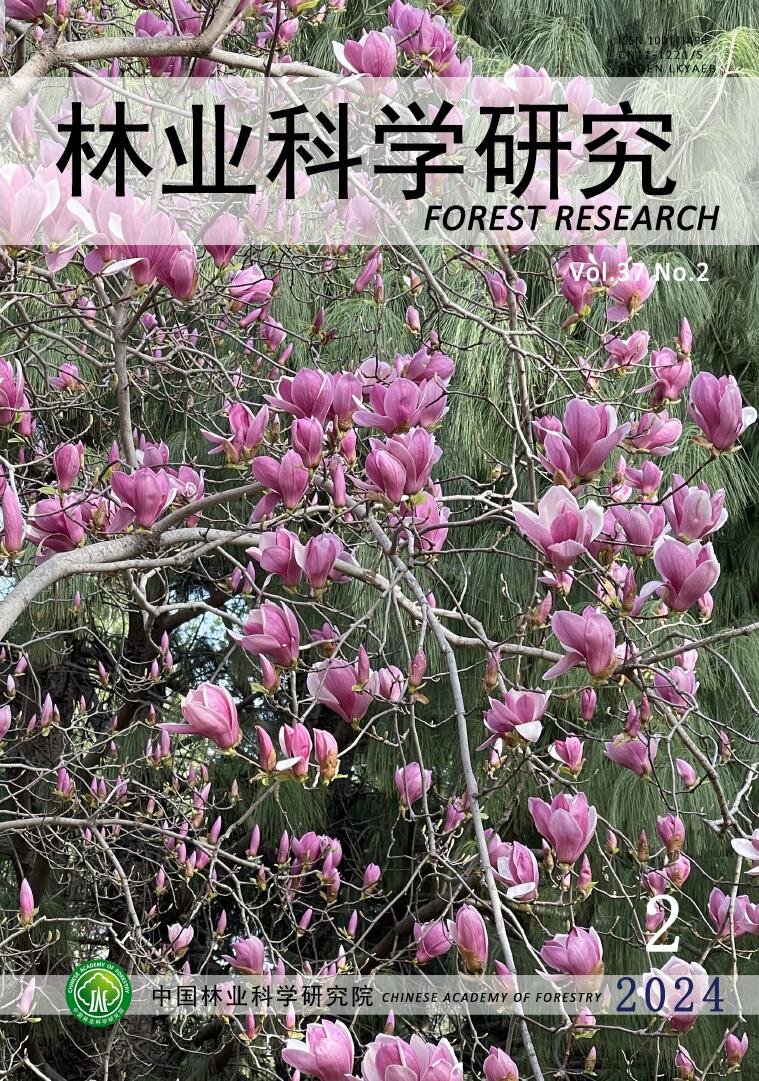-
我国政府从上世纪80年代初“六.五”林业科技支撑计划项目开始,围绕杉木(Cunninghamia lanceolata (Lamb.) Hook.)、马尾松(Pinus massoniana Lamb.)和杨树(Populus)等主要用材树种,逐步构建了以“遗传控制、立地控制、密度控制、苗木质量控制和轮伐期控制”为核心的用材林培育技术体系,林分最优轮伐期的确定是这一培育体系中的重要组成部分。在确定用材林轮伐期的采伐年龄时,主要依据林分数量成熟龄、工艺成熟龄和经济成熟龄。上世纪90年代,为满足国民经济建设对木材的需求,国内众多学者提出,要在考虑立地潜能的基础上,依据“以工艺成熟为基限,重点考虑经济成熟,适当兼顾数量成熟”的原则来确定用材林的主伐年龄[1-3]。进入21世纪,为了响应全球加快造林增汇以应对气候变化的要求,我国林业发展目前致力于提高森林质量,发挥森林多功能效益,这就需要建立以森林经营方案为基础的森林多功能培育技术体系。如何科学确定用材林的轮伐期又成为培育技术体系中的关键问题。
虽然国内外有关轮伐期的研究数量众多,但有关轮伐期的内涵、轮伐期确定的标准、不同类型轮伐期模型的选择以及相关变量对轮伐期的影响等方面,依然是众说纷纭,无法为构建用材林提质增效培育模式提供坚实的理论基础。本文通过梳理国内外有关轮伐期确定方面的研究成果,并以我国杉木用材林试验数据作为支撑,意在展示轮伐期确定的不同准则、方法和相关影响因素对轮伐期确定时的影响机理和过程,并对未来轮伐期的研究方向进行展望。
-
根据不同的林分产出目标,目前主要有6 个用材林最优轮伐期的确定准则[4]:(1)最大化总产出(Maximum Gross Yield,MGY)准则;(2)最大化可持续产出(Maximum Sustainable Yield,MSY)准则;(3)单一轮伐期收入净现值最大(Present Net Worth ,PNW)准则;(4)林地期望价值(Land Expectation Value,LEV)最大准则,也被称为无限轮伐期收入净现值最大准则或无限折现收益准则[5];(5)年净收入最大(Maximum Annual Net Revenue,MANR)准则,以及(6)资本收益率最大(Internal Rate of Return,IRR)准则。前两个准则以林分生长量为要素,不考虑林分培育过程中产生的成本和林地价值。而后4个准则兼顾林分生长和经济因素。本文基于上述6个准则建立最优化目标函数,通过数理解析得到在6个准则下轮伐期确定的最优条件(见表1),并以40年生杉木密度试验林
1 为例,比较不同准则下轮伐期的异同2 (见表2)。准则
Criteria目标函数
Objective function轮伐期确定条件
Conditions for determining rotation文献
ReferencesMGY max(T)
{pQ(T)}pQT = 0 = QT [6] MSY max(T)
{pQ(T)/T}pQT/pQ(T) = 1/T [7-9] PNW max(T)
{pQ(T)e−rT−wE}QT/Q(T) = r [10-11] LEV max(T)
{[pQ(T)e−rT−wE](1- e−rT )}pQT = rpQ(T) + rLEV [12-15] MANR max(T)
{(pQ(T) - wE)/T}l/T = pQ(T)/[pQ(T)-wE] [16] IRR max(i)
{[pQ(T)e−iT−wE]/(1-e−iT)} = 0pQT = i × pQ(T) [1-3,17-20] 注:T为林分年龄;p是活立木价格;r为折现率;i为内部收益率;wE为林地更新成本;Q(T)为林分生长量,是林分年龄的凹函数;QT为林分生长量对T的一阶导[4]。
Notes: T represents the stand age; P is the price of stumpage; r is the discount rate; i is the internal rate of return; wE is the cost of forest land renewal; Q(T) is the stand growth, which is a concave function of stand age, QT is the first derivative of Q(T) on TTable 1. Conditions for determining rotation under 6 criteria
林分年龄
AgeQ(T) QT Q(T)/T QT/Q(T) QT/[Q(T)−wE/p] i* 1/T r/(1−e−rT) 7 49.476 24.967 7.068 0.505 1.547 0.009 0.143 0.169 9 75.278 24.342 8.364 0.323 0.580 0.081 0.111 0.138 11 99.591 22.245 9.054 0.223 0.336 0.116 0.091 0.118 13 121.524 19.791 9.348 0.163 0.224 0.124 0.077 0.105 15 140.959 17.432 9.397 0.124 0.162 0.120 0.067 0.095 17 158.080 15.321 9.299 0.097 0.123 0.118 0.059 0.087 19 173.157 13.489 9.114 0.078 0.096 0.112 0.053 0.081 21 186.470 11.919 8.880 0.064 0.079 0.105 0.048 0.076 23 198.271 10.579 8.620 0.053 0.064 0.101 0.043 0.073 25 208.779 9.434 8.351 0.045 0.052 0.094 0.040 0.070 27 218.179 8.453 8.081 0.039 0.042 0.091 0.037 0.067 29 226.628 7.309 7.815 0.033 0.035 0.089 0.034 0.065 … … … … … … … … … 45 326.103 0.002 0.000 0.000 — — — — Table 2. Optimal rotations for Chinese fir plantation under 6 criteria
由表2可见,在不同准则下计算出的最优轮伐期明显不同。MGY准则下的轮伐期最长,由此确定的轮伐期其实就是用材林林分生长曲线的最高点,此后林分产出随林分年龄增加而逐步下降。在生产实践中很少依据该准则确定轮伐期,原因在于轮伐周期太过漫长,无法满足木材即时需求,尤其在生长缓慢的欧洲北部森林,据此确定的轮伐期会超过100年。IRR准则下的轮伐期最短,因为依据这一准则计算得到的资本收益率要与市场收益率相比较,市场收益率越高,依据该准则所确定的轮伐期越短[3]。MSY准则和MANR准则在该例中结果接近,在其它研究中,依据这两个准则计算得到的轮伐期也较为接近[4]。基于PNW准则的计算结果要与折现率相比较,折现率越高,依此准则确定的轮伐期越短,本例中将折现率设置为0.05时,轮伐期为23年。
在生产实践中具体采用哪个准则,要根据用材林的培育目标来确定。就目前用材林轮伐期研究来看,森林培育方向的研究者大多采用MSY准则计算用材林的数量成熟龄,林业经济的研究者主要采用LEV准则计算用材林的经济成熟龄。因此,下面主要讨论这两个准则下的轮伐期确定方法及其影响因素。
-
数量成熟龄主要根据MSY准则来确定主伐年龄。基于林分最大可持续产量理论,数量成熟龄确定的传统方法是,将林分材积的年平均生长量(Mean Annual Increment,MAI)等于连年生长量(Cumulative Annual Increment,CAI)时的林分年龄作为主伐年龄[10]。CAI函数和MAI函数均是从林分生长方程中推导出来的,CAI函数为生长方程的一阶导数,MAI为生长方程Q除以林分年龄t。虽然基于不同林分生长方程推导出的CAI和MAI函数形式不同,但都是依据CAI = MAI来确定数量成熟龄。从表达式可以看出,林分生长方程的选择对数量成熟龄的确定有决定作用。表3给出常用生长方程的形式以及利用该生长方程的数量成熟龄确定条件。
序号
No.生长方程
Growth function方程形式
Equations数量成熟龄确定条件
Condition for quantitative rotation1 Compertz模型 $ Q=kexp(-{e}^{a-bt}) $ $ {e}^{(a-bT)}={\left(bT\right)}^{-1} $ 2 Logistic模型 $ Q=\dfrac{k}{1 + {e}^{(a-bt)}} $ $ {e}^{(-a + bT)}=bT-1 $ 3 Mitschelich模型 $ Q=k(1-a{\mathrm{e}}^{-bt}) $ $ {e}^{bT}=abT + a $ 4 Richards模型 $ Q=A(1-b{e}^{-kt}{)}^{1/1-m} $ $ {e}^{bT}-b=\dfrac{kbT}{1-m} $ 5 Weibull模型 $ Q=A\left\{1-\mathrm{e}\mathrm{x}\mathrm{p}\left[-{\left(\dfrac{t}{b}\right)}^{c}\right]\right\} $ ${e}^{{\left(\frac{T}{b}\right)}^{c} }=1 + \dfrac{c}{b}{\left(\dfrac{T}{b}\right)}^{c-1}\cdot T$ 注:t为林龄;T 是数量成熟龄;k是Q的上渐近值;a为与Q初植有关的参数;b为内禀生长率;c为形状参数;m为曲线形状及拐点位置参数
Notes: t represents the stand age; T is the quantitative rotation; k is the upper asymptotic value; a is the parameter related with the initial Q value; b is the intrinsic growth rate; c is the shape parameter; m is the curve shape inflection point position parameterTable 3. Condition for quantitative mature age under difference growth functions
利用5个生长方程,拟合不同初植密度下40年生杉木用材林生长进程并求解轮伐期(表4)。5个方程下的轮伐期均随着林分初植密度的增大而增加,不同方程下轮伐期之间的差异随着初植密度的增大而增加。当初植密度较小时,生长方程的形式对确定轮伐期影响不大。当初植密度达到6 666 株·ha−1时,用Weibull方程求算的轮伐期要比用Mitschelich方程计算的轮伐期短8年,比用Compertz方程计算的轮伐期短12年。因此,在利用数量轮伐期来确定用材林主伐年龄时,造林密度因素是必须要考虑的因素。相聪伟等[21]和段爱国等[22]对杉木密度效应进行研究的结果也证明了这一观点。
初植密度
Initial planting density
(Number·ha−1)生长方程形式
Functions of growthCompetz Logistic Mitschelich Richards Weibull 1666 16 17 18 17 17 3333 18 19 19 19 18 5000 25 23 28 24 25 6666 38 29 34 27 26 10000 38 29 32 27 29 Table 4. Optimum rotation of Chinese fir plantation under different density
利用不同生长方程求算的轮伐期结果之间差异很大。这说明数量成熟龄的确定与生长方程形式有关。在生产实践中确定最优轮伐期时,对生长方程的选择要慎重。另外,生长方程参数估计值与采用的估计方法也有关系,如何选择参数估计方法参见孙洪刚等[23]的相关研究,这里不再赘述。理论上,生长方程的选择应遵循如下原则:要充分反映林分真实生长进程;对不同培育措施(如,林分密度、立地质量和抚育间伐等)具有相容性;模型结构要尽可能简单,且模型参数具有明显的生物学意义[24]。
-
经济成熟龄主要依据LEV准则来确定轮伐期。1849年Faustmann在假定林地无限期连续轮伐作业的基础上,将木材收益增加值与木材延迟采伐所增加成本相等时的林分年龄,作为林分最优轮伐期,此时生产的边际收入等于投入的边际成本[25]。Faustmann模型的基本形式是:
上式中, p 是活立木价格;V为林分材积,它是林分年龄t的函数;c 是更新成本;r是折现率。在Faustmann模型框架下,最优轮伐期就是林地期望价值最大时所对应的林分年龄。由于该模型包含林分机会成本和土地机会成本,被认为是“计算最优轮伐期的最准确的模型”[8]。因此,林地期望价值模型成为众多研究最优轮伐期的理论基础。Faustmann假设活立木价格、林分材积、更新成本和折现率在各轮伐期之间都是相等的,由此导致了在不同轮伐期主伐年龄相同的问题。更为重要的是,这些假设也隐含了林地所有者期望林地价值永远不变的思想[25]。事实上,由于上述假定不变的因素在同一轮伐期和不同轮伐期都会发生变化,对土地期望价值和轮伐期都会产生重要的影响。为此,研究人员对Faustmann模型进行了扩展,主要通过加入影响经济成熟龄的各类影响因素,如林分生长因子、培育措施因子、经济因素以及各种风险或者不确定性因素。表5总结了近些年国内外学者对Faustmann模型的扩展方向以及相关主要研究结论。
扩展方向
Direction主要研究结论
Main conclusions文献
References考虑初植密度和间伐 初植密度对轮伐期有重要的影响,初植密度相同时,没有间伐的林分轮伐期比间伐林分的轮伐期短。 [25-33] 考虑活立木价格变化 立木价格增加,轮伐期相应缩短。立木质量越好(如,径阶越大),价格越高,如果此时提高立木的价格可能会延长轮伐期。 [34-39] 加入立地条件 立地条件对轮伐期的影响表现出非单调性。立地条件较差的林分,轮伐期对盈利影响不大,但是立地条件好的林分,轮伐期的确定对盈利有很大的影响。 [40-42] 加入非木材收益 加入非木材收益后倾向于延长轮伐期(如,考虑碳存储价值)。 [43-47] 考虑折现率的变化 当折现率较高时,林地价值对轮伐期的变化更敏感。折现率较低时,林地价值不稳定。 [8,29,33,47-50] 加入不确定性因素 森林价值对多种风险和不确定性很敏感。木材价格的变化比其它风险(如,风灾、病虫害等)造成的经济损失更大。但价格的不确定性,并不意味着对轮伐期有显著影响。 [51-56] Table 5. Expansions for Faustmann model
为了展示利用Faustmann模型确定的经济成熟龄,本文使用40年杉木密度试验林定期观测数据,在计算时考虑不同径阶杉木活立木价格差异,求解5个初植密度下不同折现率时的最优经济轮伐期(见表6)。结果表明,随着初植密度增加,最优经济轮伐期的变化呈非单调性。初植密度较小时,随着初植密度增加,最优经济轮伐期缩短;初植密度较大时,随着初植密度增加,最优经济轮伐期反而会延长。当折现率较低时,不同初植密度林分的最优经济轮伐期差异较小。
初植密度
Initial planting density (Number·ha−1)r = 0.01 r = 0.02 r = 0.03 r = 0.04 r = 0.05 r = 0.06 r = 0.07 r = 0.08 r = 0.09 1667 20 18 17 17 16 15 13 11 8 3333 19 16 15 15 13 12 11 10 9 5000 18 15 15 14 13 13 11 11 10 6667 19 18 17 17 16 14 13 13 13 10000 20 19 18 18 17 17 16 15 15 Table 6. Optimal rotations for Chinese fir plantation using different initial planting densities and discount rates
-
Faustmann模型要求所有变量必须是时间的确定性函数,从而得出活立木价格增加将会缩短轮伐期的结论。而现实的经济社会中,活立木的价格具有不确定性,是随机波动的。因此,有学者将研究活立木未来价格的不确定性以及与价格波动相关的实物期权理论应用到林业生产研究中[57-58]。利用实物期权理论分析林地价值的研究可以分为两类,一类视活立木价格是平稳的[59-60];另一类将活立木价格视为非平稳的[36,61-62],并用分数布朗运动[63]、自回归条件异方差效应[64]、几何布朗运动[65]、自相关随机过程[66]来描述价格的变化。但Jacobsen[39]指出,利用实物期权理论计算得到的最优轮伐期不能同Faustmann模型计算出的轮伐期进行比较。因为如果不考虑活立木价格服从何种数据生成过程,单独考虑价格对轮伐期的影响,会得出当活立木价格增加,轮伐期将缩短的结论。但是如果考虑与价格相关的其他因素时,价格与轮伐期之间的关系就不能确定了。比如,Hyde[67]就发现,由于价格水平和价格增长率之间的相互影响,价格提高所带来的效应是不确定的。Hardie,Daberkow和Mc Connel[68]在考虑活立木价格和生产成本都随时间变化时,假设允许林地在未来可以另作它途,发现最优轮伐期与价格和折现成本之间的关系也是不确定的。
在确定最优轮伐期时,价格和木材质量之间的关系也被认为是制定主伐和培育模式的重要依据[69]。在多数早期的研究中,活立木不同径阶(木材质量)间的价格差异被忽视了[34],直到Zhou[26]分析欧洲赤松(Pinus sylvestris L.)木材质量对木材价格的影响时,木材质量才在最优轮伐期的研究中考虑进来。Hyytiäinen等人 [70-71] 在单木生长模型中加入了木材质量对木材价格的影响,证明了初植密度、木材质量、木材价格之间是密切相关的。如果考虑了木材质量,价格与最优轮伐期的关系与标准的Faustmann模型的结论是相反的[72-73]。比如,Brazee和Dwivedi[74]发现不同规格木材的价格会直接影响最优轮伐期,尤其是木材径阶越大,价格越高,而木材价格提高会延长最优经济轮伐期。由此可见,有关价格和轮伐期之间的结论都是在一定假设条件下的,条件不一样,结论也不一样。
-
尽管初植密度对林分生长动态有非常重要的影响,但是有关初植密度对林地价值的影响却鲜见报道[68]。初植密度不仅仅决定木材生产利润,还可能决定其它林分培育措施应用的规模和范围。如何反映初植密度对轮伐期的影响也就成为不可回避的重要问题之一。Chang[25] 在Faustmann和Hyde[67]以及 Hirshleifer[75]这些早期研究的基础上,为后来的学者建立了数量分析框架,并得到了广泛的认可和应用[52,76-77]。比如,Liu 等人 [78]在Chang的框架下提出确定初植密度对最优经济轮伐期的作用时要把握两个关键:一是林分材积增长率与折现率的大小关系,如果林分材积增长率高于折现率时,初植密度对最优经济轮伐期具有负向影响,反之为正向;另一个关键是初植密度对木材质量的影响,低密度林分会随林分年龄增加而立木价格差异大,对最优轮伐期的影响也大,并认为在人工成本日益增加的情况下,采用皆伐生产木材的林分应采用低密度造林,但最低密度如何确定还有待于进一步的研究。
间伐是林分密度调控的重要手段。虽然Faustmann在最初的LEV模型中考虑了间伐因素,但Samuelson[79]为了方便对其模型进行经济分析,并没有考虑间伐因素。此后,多数经济学家在研究轮伐期时也将间伐因素摒弃。Chang[25]分析初植密度和轮伐期之间的关系时也没有涉及间伐。因为他怀疑任何对初植密度与轮伐期模型的扩展,比如加入间伐因子,将会导致模型更高的复杂性,而这种复杂性将可能不会得到有意义的结果。但他同时指出,间伐对最优轮伐期的影响是非常重要的,仅对林地价值的贡献就可达到40%[80]。为此,关于初植密度、间伐和轮伐期三者关系的研究再次受到重视[28]。目前,此类研究大都应用动态规划[32]或者庞特里亚金(Pontryagin)的最大化原则[29,31,33,56],比如,Hool[81]应用动态规划马尔柯夫链研究木材间伐与主伐问题时,在假设木材生长具有随机性情况下,提出了最优间伐和皆伐策略。Clark 和De Pree[29]以及Cawrse 等人[33]在利用Faustmann-Pressler-Ohlin理论比较有无间伐对轮伐期的影响时,假设两者的初植密度是相同的,并推断出没有间伐的轮伐期比有间伐林分的轮伐期短。而从树种类型来说,有研究认为,针叶树应该进行高密度造林,然后通过多次间伐,获得较高的间伐收益[77,52-53,82]。而有些研究结论恰好相反,认为针叶树应该直接用最终皆伐密度进行低密度造林[26,78]。事实上,随着劳动力价格逐年增加,间伐的人工成本越来越高,甚至超过间伐收入,因此,在中国的很多杉木林区,出现了即使林分已经郁闭甚至发生自疏也不进行抚育间伐的现象。张水松等通过杉木抚育间伐强度试验,认为间伐可以促进杉木直径生长和单株材积生长,但不能提高林分总出材量[83]。因此,在林分总出材量稳定的情况下,提高林业生产效率的唯一途径就是通过减少劳动力投入以节约生产成本。
-
森林从苗木繁育、整地造林、除草施肥、抚育间伐、日常管护到主伐整个营造林生产过程所支出的直接费、管理费和固定资产折旧费等,都应计入森林培育成本。因此,不同树种的用材林,从育苗造林到木材采伐,几乎年年都产生生产费用,构成生产成本。关于生产成本,Campell H.[84]指出:直接成本不会影响最优轮伐期,因为它是固定投入。但是,它会影响裸地造林的经济可能性。所有未来轮伐收入的现值必须高于直接成本,造林才会有收益,生产单位才会从事营造林生产。关于用材林培育的直接成本变化也是很复杂的。有些成本与初植苗木数量呈正相关,比如初植密度越大,则造林成本越高,但高密度造林会降低抚育成本;间伐强度越大,人工成本越高,但木材质量越好,相应木材收益也越大。因此,培育措施对成本的影响在确定最优经济轮伐期时应该予以考虑。
另外,折现率或者利率对最优轮伐期和土地期望值的影响也是不容忽视的[31,48-49,54,85]。在典型的Faustmann模型下,采伐年龄在各轮伐期是不变的。Amacher 等人[86]在此条件下利用比较静态分析证明了折现率提高会缩短轮伐期;更新成本增加会延长轮伐期。但是这些结论都是在假设成本与折现率是确定性的条件下得出的,事实上,林业生产周期长,经济因素随着时间发生变化,必然会影响森林培育决策,经济因素的不确定性将使得对最优轮伐期的研究更加复杂。目前,多数学者先使用确定的成本和折现率计算轮伐期,然后在敏感性分析中将成本、折现率的变化进行主观设置,进而分析其变化对轮伐期的影响。如果把用材林培育视为一种长期投资,那么成本、折现率这些经济因素的不确定性如何体现在最优轮伐期的理论模型中,将值得关注。
-
通过上述理论分析和实证结果可以看出,最优轮伐期是特定立地条件、经济环境以及定向培育措施共同作用下的结果。传统上,最优轮伐期的应用仅限于在外部给定的条件下来确定主伐年龄。然而,当进行初始造林时,森林所有者通常面临着初植密度大小、成本投入高低的不同选择,并且随着林龄的变化,活立木价格、利率等市场情况经常变化,导致最优轮伐期的变化规律极为复杂,未来仍然需要在以下几方面进行探索。
(1)最优初植密度的确定。用材林最优轮伐期的研究在向林分密度调控方向进行扩展时,一个关键的因素是初植密度。初植密度的重要性表现在:它决定了林分首次间伐时的林分年龄,密度越大,首次间伐时的林分年龄越小;它通过对木材质量的影响使得木材价格在不同径阶上的分布不同;初植密度越大,初植成本越高。因此,确定最优初植密度要在这三个方面实现平衡。简单地说,初植密度就是造林的初始投入,轮伐期就是何时主伐获得产出收益,这种投入产出关系决定了林业生产效率的高低。因此,对由初植密度和轮伐期的变化所导致的森林管理生产应用和理论分析都非常重要。
(2)不确定性因素对轮伐期的影响。用材林分从造林到主伐,一般要经过10~50年的培育周期。在漫长的生长过程中,林分要经受病虫害和风、雪、火灾等自然灾害,以及由于管理不当所引起的毁林和无法成林等问题,林业投资不能回收的可能性很大,这就要求按复利计算立木价格,以保证林业生产的经济可持续性。另外,在林木不同生长阶段,培育林木的投资也年年不断发生,所形成的利息也年年相应增加。在传统的用材林培育模型中,立木价格、林分培育成本和折现率都假定为时间的确定性函数,但用于实际培育决策则常常是不适宜的,因为市场的变动有很多的不确定性。如何分析这种不确定性对用材林培育决策的影响,制定适应培育策略,对森林培育者是一个很重要的问题。
Research Progress in the Optimal Rotation of Forest Plantations Based on Experimental data
- Received Date: 2023-08-17
- Accepted Date: 2023-10-10
- Available Online: 2024-04-27
Abstract: Although the study of forest rotation has attracted the attention of many scholars both domestically and internationally, there are still divergent opinions on the connotation of optimal forest rotation, the criteria for determining the optimal forest rotation, the criteria for determining the rotation, and the impact of related variables on the optimal forest rotation, which cannot provide a solid theoretical basis for developing a cultivation model for improving forest plantations. This paper summarized the research results on determining the optimal forest rotation, and used experimental data of Chinese fir plantations to demonstrate the different criteria, methods, and influencing factors in determining the optimal forest rotation. It also provides prospects for future research directions.





 DownLoad:
DownLoad: